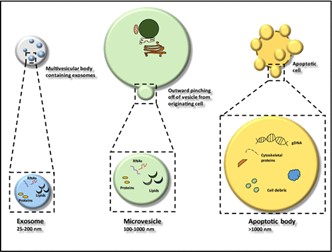The term Extracellular Vesicles (EVs) is the generic name for particles naturally released from the cell, characterized by a limited lipid bilayer and cannot replicate, (i.e do not contain a functional nucleus). The biochemical composition of extracellular vesicles (EVs) mainly consists of lipids, proteins, and nucleic acids.
Derived from cells, extracellular vesicles (EVs) obtain their appearance based on the cargo transferred from the donor cells, known as their molecular signature.
A general consensus on EVs nomenclature has been made, on the basis of their size, formation and release mechanism:
- Small EVs, known as exosomes, are derived from the endosomal membrane. Exosomes are secreted via exocytosis from the late endosome multivesicular bodies (MVBs) and their size range from 50 to 150 nm in diameter.
- Medium EVs, known as microvesicles (previously named microparticles) are released by activated and apoptotic cells by cell-surface membrane blebbing. Their size ranges from 100 to 1000 nm in diameter. Due to the presence of phosphatidylserine (PS), on subsets of microvesicles, and/or the presence of Tissue Factor (TF) these MVs are described as procoagulant entities.
- Apoptotic bodies are large EVs, generated only by blebbing of cells undergoing apoptosis. Contrary to the traditional belief that apoptotic bodies are simply just random debris from dying cells, apoptotic bodies are increasingly recognized as crucial immune regulators and disease biomarkers.
| Size | Cell origin | |
| Small EVs - Exosomes | 50 – 150 nm | Exocytosis from the late endosome MVBs. |
|
Medium EVs - Microvesicles |
100 – 1000 nm | Cell-surface membrane blebbing of activated and apoptotic cells. |
| Large EVs– Apoptotic bodies | >1000 nm | Blebbing of cells undergoing apoptosis. |
EVs have been reported to mediate many normal cellular processes such as cell proliferation, differentiation, and migration. They can also promote the transfer of genetic information and the delivery of therapeutic molecules.
In addition, EVs can act as signal mediators that regulate gene expression, angiogenesis, immune responses, and cell metabolism.
The pathology of many diseases, including arterial thrombosis, is characterized by elevated concentrations of circulating EVs.


